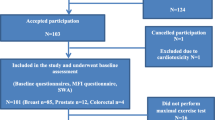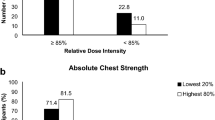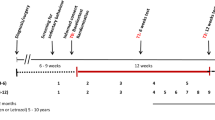Abstract
We examined cardiorespiratory fitness (CRF) levels in early stage breast cancer patients and determined whether CRF differs as a function of adjuvant therapy regimen. A total of 180 early breast cancer patients representing three treatment groups (surgery only, single-, and multi-modality adjuvant therapy) in the Cooper Center Longitudinal Study (CCLS) were studied. A non-cancer control group (n = 180) matched by sex, age, and date of the CCLS visit was included. All subjects underwent an incremental exercise tolerance test to symptom limitation to assess CRF (i.e., peak metabolic equivalents [METs] and time to exhaustion). The mean time from breast cancer diagnosis to exercise tolerance testing was 7.4 ± 6.2 years. In adjusted analyses, time to exhaustion and peak METs were incrementally impaired with the addition of surgery, single-, and multi-modality adjuvant therapy compared to those of matched controls (p = 0.006 and 0.028, respectively). CRF was lowest in the multi-modality group compared to all other groups (all p’s < 0.05). Despite being 7 years post-diagnosis, asymptomatic early breast cancer survivors have marked reductions in CRF. Patients treated with multi-modal adjuvant therapy have the greatest impairment in CRF.


Similar content being viewed by others
Abbreviations
- CVD:
-
Cardiovascular disease
- CCLS:
-
Cooper Center Longitudinal Study
- METs:
-
Metabolic equivalents
- LVEF:
-
Left ventricular ejection fraction
- CRF:
-
Cardiorespiratory fitness
- ECG:
-
Electrocardiogram
- ANCOVA:
-
Analysis of covariance
References
Siegel R, Naishadham D, Jemal A (2012) Cancer statistics, 2012. CA Cancer J Clin 62(1):10–29
Jemal A, Siegel R, Ward E, Murray T, Xu J, Smigal C, Thun MJ (2006) Cancer statistics, 2006. CA Cancer J Clin 56(2):106–130
Jones LW, Haykowsky MJ, Swartz JJ, Douglas PS, Mackey JR (2007) Early breast cancer therapy and cardiovascular injury. J Am Coll Cardiol 50(15):1435–1441
Lakoski SG, Eves ND, Douglas PS, Jones LW (2012) Exercise rehabilitation in patients with cancer. Nat Rev Clin Oncol 9(5):288–296
Ewer MS, Lippman SM (2005) Type II chemotherapy-related cardiac dysfunction: time to recognize a new entity. J Clin Oncol Off J Am Soc Clin Oncol 23(13):2900–2902
Jannazzo A, Hoffman J, Lutz M (2008) Monitoring of anthracycline-induced cardiotoxicity. Ann Pharmacother 42(1):99–104
Hsia CC, Ramanathan M, Estrera AS (1992) Recruitment of diffusing capacity with exercise in patients after pneumonectomy. Am Rev Respir Dis 145(4 Pt 1):811–816
Jones LW, Eves ND, Haykowsky M, Joy AA, Douglas PS (2008) Cardiorespiratory exercise testing in clinical oncology research: systematic review and practice recommendations. Lancet Oncol 9(8):757–765
Gupta S, Rohatgi A, Ayers CR, Willis BL, Haskell WL, Khera A, Drazner MH, de Lemos JA, Berry JD (2011) Cardiorespiratory fitness and classification of risk of cardiovascular disease mortality. Circulation 123(13):1377–1383
Myers J, Prakash M, Froelicher V, Do D, Partington S, Atwood JE (2002) Exercise capacity and mortality among men referred for exercise testing. N Engl J Med 346(11):793–801
Blair SN, Kohl HW III, Paffenbarger RS Jr, Clark DG, Cooper KH, Gibbons LW (1989) Physical fitness and all-cause mortality. A prospective study of healthy men and women. JAMA 262(17):2395–2401
Blair SN, Kohl HW III, Barlow CE, Paffenbarger RS Jr, Gibbons LW, Macera CA (1995) Changes in physical fitness and all-cause mortality. A prospective study of healthy and unhealthy men. JAMA 273(14):1093–1098
Lakoski SG, Barlow CE, Farrell SW, Berry JD, Morrow JR Jr, Haskell WL (2011) Impact of body mass index, physical activity, and other clinical factors on cardiorespiratory fitness (from the Cooper Center Longitudinal Study). Am J Cardiol 108(1):34–39
Pollock ML, Foster C, Schmidt D, Hellman C, Linnerud AC, Ward A (1982) Comparative analysis of physiologic responses to three different maximal graded exercise test protocols in healthy women. Am Heart J 103(3):363–373
Pollock ML, Bohannon RL, Cooper KH, Ayres JJ, Ward A, White SR, Linnerud AC (1976) A comparative analysis of four protocols for maximal treadmill stress testing. Am Heart J 92(1):39–46
Ho JS, Fitzgerald SJ, Barlow CE, Cannaday JJ, Kohl HW III, Haskell WL, Cooper KH (2010) Risk of mortality increases with increasing number of abnormal non-ST parameters recorded during exercise testing. Eur J Cardiovasc Prev Rehabil Off J Eur Soc Cardiol Work Groups Epidemiol Prev Cardiac Rehabil Exerc Physiol 17(4):462–468
Peel JB, Sui X, Adams SA, Hebert JR, Hardin JW, Blair SN (2009) A prospective study of cardiorespiratory fitness and breast cancer mortality. Med Sci Sports Exerc 41(4):742–748
Ainsworth BE, Haskell WL, Whitt MC, Irwin ML, Swartz AM, Strath SJ, O’Brien WL, Bassett DR Jr, Schmitz KH, Emplaincourt PO et al (2000) Compendium of physical activities: an update of activity codes and MET intensities. Med Sci Sports Exerc 32(9 Suppl):S498–S504
Jones LW, Courneya KS, Mackey JR, Muss H, Pituskin EN, Scott JM, Hornsby WE, Coan AD, Herndon JE II, Douglas PS et al (2012) Cardiopulmonary function and age-related decline across the breast cancer survivorship continuum. J Clin Oncol 30(20):2530–2537
Froelicher VF Jr, Thompson AJ Jr, Davis G, Stewart AJ, Triebwasser JH (1975) Prediction of maximal oxygen consumption. Comparison of the Bruce and Balke treadmill protocols. Chest 68(3):331–336
Hermansen L, Saltin B (1969) Oxygen uptake during maximal treadmill and bicycle exercise. J Appl Physiol 26(1):31–37
Khakoo AY, Yeh ET (2008) Therapy insight: management of cardiovascular disease in patients with cancer and cardiac complications of cancer therapy. Nat Clin Pract Oncol 5(11):655–667
Darby SC, Cutter DJ, Boerma M, Constine LS, Fajardo LF, Kodama K, Mabuchi K, Marks LB, Mettler FA, Pierce LJ et al (2010) Radiation-related heart disease: current knowledge and future prospects. Int J Radiat Oncol Biol Phys 76(3):656–665
Yeh ET, Tong AT, Lenihan DJ, Yusuf SW, Swafford J, Champion C, Durand JB, Gibbs H, Zafarmand AA, Ewer MS (2004) Cardiovascular complications of cancer therapy: diagnosis, pathogenesis, and management. Circulation 109(25):3122–3131
Hudson MM, Ness KK, Nolan VG, Armstrong GT, Green DM, Morris EB, Spunt SL, Metzger ML, Krull KR, Klosky JL et al (2011) Prospective medical assessment of adults surviving childhood cancer: study design, cohort characteristics, and feasibility of the St. Jude Lifetime Cohort Study. Pediatr Blood Cancer 56(5):825–836
Acknowledgments
LWJ is supported in part by Research Grants from the National Cancer Institute (CA143254, CA142566, CA138634, CA133895, CA164751).
Conflict of interest
The authors declare no conflicts of interest.
Author information
Authors and Affiliations
Corresponding author
Rights and permissions
About this article
Cite this article
Lakoski, S.G., Barlow, C.E., Koelwyn, G.J. et al. The influence of adjuvant therapy on cardiorespiratory fitness in early-stage breast cancer seven years after diagnosis: the Cooper Center Longitudinal Study. Breast Cancer Res Treat 138, 909–916 (2013). https://doi.org/10.1007/s10549-013-2478-1
Received:
Accepted:
Published:
Issue Date:
DOI: https://doi.org/10.1007/s10549-013-2478-1




